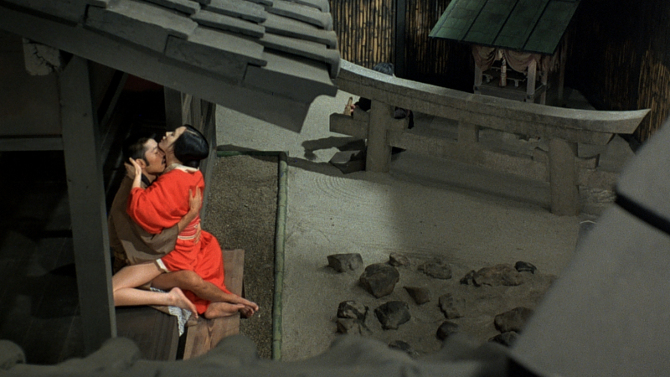In the Realm of the Senses has been called eroticism, a sharp political statement, an arthouse film, pornography, as well as a searing drama, and, it is likely that it has been defined as being so many other things as well. Like most boundary pushing pieces of art, it transcends the ability to label it as just one of these descriptive terms, combining all of them to create a unique and ever controversial piece of cinema.
Released in 1976, it was only able to be made in the first place thanks to it being a Japanese/French co-production (listed as a French enterprise) – the unfinished film had to be shipped out of Japan and into France to avoid issues with strict Japanese censorship laws (it was processed and edited in Europe because of it). Banned in most countries upon first release (with many only lifting it completely in the 1990s and 2000s) – though it showed at numerous film festivals (the Cannes Film Festival had to orchestrate thirteen screenings due to demand), In the Realm of the Senses is still censored in Japan to this day.
Written and directed by Nagisa Ôshima (the filmmaker was charged with obscenity after publishing the screenplay – though he was acquitted after a four year trial), the story is set in 1936, as rampant militarism, growing imperialism and increased governmental control permeate the country. Sada Abe (Eiko Matsuda), a former prostitute, has found employ in a hotel owned by Kichizo Ishida (Tatsuya Fuji), a married man – let’s just say he dabbles outside of his marriage.
He soon spots the new employee in Sada and it does not take long for him to bed her. The two begin a torrid love affair – with Kichizo departing his hotel (and his wife) to continue his dalliances in a private location. The pair become more and more possessive (especially Sada), as they grow more reclusive in their relationship – cloistering together in their room. The outside world, and usually important things like food and money are recklessly ignored as they turn inward.
As they delve deeper into their perfervid bond, things take a more sadomasochistic and destructive turn. They both relish their unusual relationship, with Kichizo slowly becoming more subservient and eager to please. Will the twosome be able to survive their fervent tryst, or will they fall prey to their reckless desires?
Speaking to so many issues, perhaps the most telling scene shows a dazed Kichizo meandering through the city streets of Tokyo, going against the grain of the military as they march in front of patriotic citizens as he stupors by – the only one headed in the other direction. Funnily enough, this scene was nearly cut. When director Ôshima discussed this with his star and leading man Fuji, the actor divulged that it was this scene that convinced him to take on the role (and that he wasn’t comfortable with it being edited out) – trusting Fuji, he kept the scene in. A smart choice, this sequence in many ways encapsulates the main themes of the story. A few years off from the start of World War II, the imperialistic nature of Japan (with more stringent government control), expectant that its population would dutifully toe the line, is combatted by this couple who ignore the state and populist movement – disregarding everything but their own emotions. It is perhaps fitting that the word ‘realm’ is used in the film’s title (empire is utilized for the French translation), as the pair are not subservient to any realm other than to their own private, sensual one.
Filmed with a striking style, Ôshima utilizes vivid colours and interesting angles to depict a complex, sexually driven relationship. The story’s analysis of an intimate, heated, carnal affair brings up the idea of those intense feelings of the early stages of love (passion, obsession), if they can last, or whether they will wither over time? Do the algolagnic ways of the couple prolong those carnal desires, or are they reckless actions that lead down a slippery slope? Is there a way to capture and salvage the beauty of erotic love at its highest form, or will time always force passion to melt away? The jarring finale, which is then revealed to be based on real events, leaves the viewer with much to contemplate after the film comes to an end.
The set and costume design must also be commended, as it truly transports us to 1930s Japan.
It is hard to fathom the quality of the acting – the two leads deserve kudos for delivering such realistic and authentic performances in such explicit, daring situations.
Controversial to say the least, In the Realm of the Senses depicts sexuality in a way that is rare for the silver screen (full disclosure, the acts in this motion picture are real) – Fifty Shades of Grey has nothing on this boundary breaking movie. It has a hypnotic quality that is hard to shake. So, fix a date to see this contentious, asphyxiating film about a sequestered romance that is forever intriguing.

